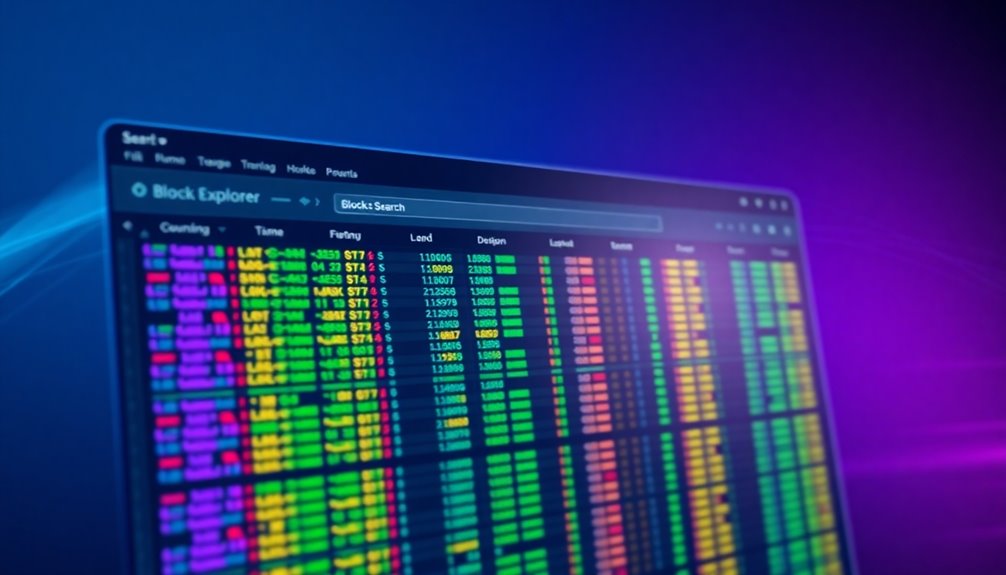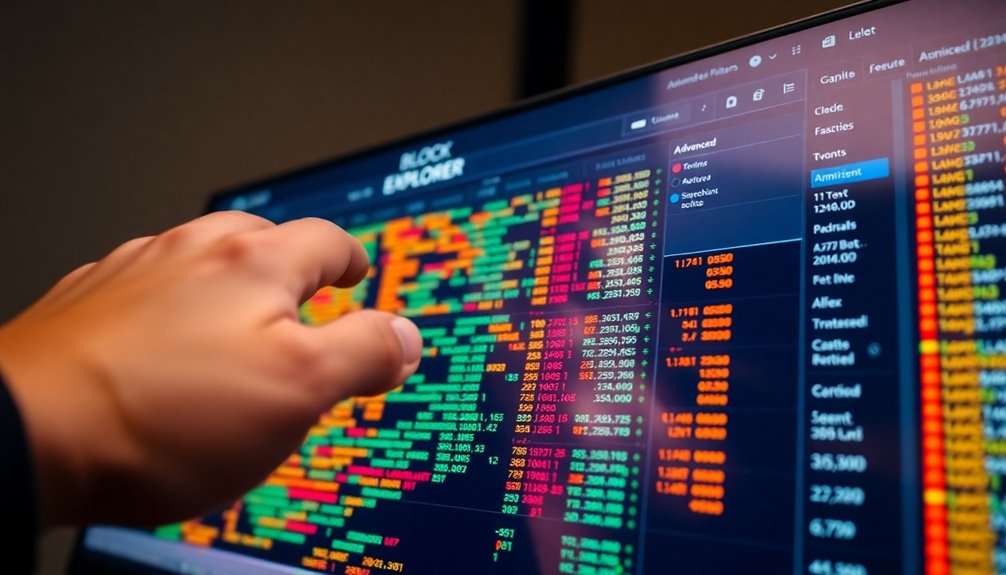A block explorer is a handy tool that allows you to access and analyze blockchain data with ease. You can track specific transactions or wallet addresses using transaction hashes, revealing crucial details like block height, miner info, and transaction timestamps. It offers insights into network statistics like hash rates and block difficulty, promoting transparency in cryptocurrency activities. While it provides real-time updates, the reliability of data can vary. Understanding how to navigate these tools can enhance your blockchain experience and keep you informed about key aspects of transactions and network performance. There's much more to explore!
Key Takeaways
- A block explorer is a user-friendly tool for exploring blockchain data and tracking transactions and wallet addresses.
- It displays detailed block information, including miner data, transaction counts, and timestamps.
- Users can analyze network statistics, such as hash rates and block difficulty, through block explorers.
- They facilitate real-time tracking of transaction statuses using unique transaction hashes or IDs.
- Security risks, such as phishing attacks and data integrity issues, highlight the importance of using legitimate block explorers.
Core Functionality Overview

When you want to immerse yourself in the details of a blockchain, a block explorer is your go-to tool. It provides a user-friendly interface to explore important blockchain data, including transaction history, blocks, and addresses.
You can easily use the search bar to find specific transactions or wallet addresses by entering transaction hashes. Each block's details, such as block height, miner data, transaction counts, and timestamps, are readily available, ensuring transparency in blockchain activities.
Additionally, you can analyze essential network statistics, like hash rates and block difficulty, which are significant for evaluating the blockchain's health and activity.
Whether you're using Etherscan for Ethereum or Blockchain.com for Bitcoin, a block explorer is invaluable for your blockchain journey.
Overview of Block Explorer Features

Block explorers are packed with features that enhance your ability to navigate and analyze blockchain data. You can track the status of specific transactions using a transaction hash or wallet addresses, allowing for real-time insights.
Key features include detailed analytics on individual blocks, transaction verification, and network statistics like hash rate and block difficulty. You'll also gain information about transaction fees and the mempool size, ensuring transparency and accountability in the ecosystem.
Popular blockchain explorers, such as Etherscan for the Ethereum network and blockchain.com for Bitcoin transactions, provide tailored functionalities that make it easier for you to understand your data and assess the overall health of a cryptocurrency, including circulating supply and market capitalization.
Transaction Tracking Mechanism

Tracking transactions on a blockchain is straightforward with block explorers, which allow you to input a unique transaction hash or ID to retrieve detailed information about its status.
You'll find critical data such as the amount sent, transaction fees, timestamps, and the associated wallet addresses.
Block explorers also let users monitor unconfirmed transactions in the mempool, showcasing pending transactions waiting to be added to the next block.
Additionally, you can categorize transactions, distinguishing between internal transactions and ERC20 token movements. This feature helps users track various asset transfers more efficiently.
With real-time updates as miners solve blocks, block explorers guarantee you always have the latest information on your transactions' progress.
Pros and Cons Summary

While block explorers offer valuable tools for monitoring blockchain activity, they come with both advantages and drawbacks.
On the plus side, these tools give you real-time access to blockchain data, allowing you to track transaction IDs, verify addresses, and efficiently monitor the blockchain network. They also enhance transparency, helping you analyze transaction histories and gain insights into wallet behaviors and market trends.
However, the reliability of data can vary, depending on the blockchain updates and the tool's infrastructure. Additionally, information from block explorers is for informational purposes only and shouldn't be seen as financial advice.
Finally, you'll need a basic understanding of blockchain mechanics to navigate these explorers effectively, which can be a barrier for newcomers.
Feature Evaluation Across Platforms

When exploring the world of blockchain, understanding the different features offered by various block explorers can greatly enhance your experience.
For instance, Etherscan excels in providing detailed analytics on Ethereum transactions, smart contracts, and token transfers. In contrast, Bitcoin explorers like Blockchain.com focus more on transaction histories and essential block details for Bitcoin.
Multi-currency explorers, such as Blockchair, allow you to analyze various cryptocurrencies and compare network metrics like transaction volumes and fees. Some explorers, like BscScan, even include unique functionalities tailored to their ecosystems, like tracking token burns.
You'll also notice differing user interfaces across platforms, with some offering intuitive navigation while others provide advanced tools for visualizing transaction histories and market activity.
Security Vulnerabilities in Explorers

Understanding the security vulnerabilities in block explorers is essential for anyone traversing the blockchain landscape.
Block explorers can fall victim to phishing attacks where malicious actors create fake versions to steal your private information. You should be aware that outdated software or a lack of regular updates can expose your data and transaction information to exploitation.
Additionally, some block explorers may face issues with data integrity, displaying incorrect or manipulated data that misleads you about transaction statuses or balances.
APIs used by block explorers are also at risk, potentially leading to denial-of-service attacks if not properly secured.
Always exercise caution and verify the legitimacy of block explorers to protect your security and avoid losing funds.
Emerging Block Explorer Technologies

As blockchains evolve, so do the tools we use to navigate them, leading to exciting advancements in block explorer technologies.
Emerging block explorers now incorporate AI-driven analytics that enhance data interpretation and predict transaction trends within networks. With real-time alerts for significant transactions, you'll find it easier to monitor your assets.
Multi-chain compatibility is also on the rise, allowing you to access and track activities across various blockchain ecosystems from a single platform. Enhanced user interfaces simplify navigation, making it more intuitive for those unfamiliar with blockchain technology.
Ultimately, future block explorers might utilize decentralized architecture to boost security and trustworthiness, ensuring the information provided remains immutable and protected from central points of failure.
Utilize Advanced Filter Options

Emerging block explorer technologies have greatly enhanced how you interact with blockchain data, particularly through advanced filter options. These options let you refine searches by parameters like transaction status—whether confirmed or unconfirmed—block height, date range, and amount.
You can also filter transactions by type, such as ERC20 token transfers, to focus on specific asset movements within the Ethereum block. Additionally, using filters for wallet address activity helps you track transactions involving certain addresses, which is perfect for monitoring known wallets or whale activity.
Frequently Asked Questions
What Is Block Explorer Used For?
You use a block explorer to verify transaction statuses and track whether they're completed or still pending.
It helps you confirm successful block mining and analyze important network metrics like hash rate.
If you're running a business, it allows you to monitor market trends and customer behaviors.
You can also observe whale activity and analyze large transactions, providing valuable insights into market sentiment and helping you make informed decisions.
Is Block Explorer Safe?
Yes, block explorers are generally safe to use. They provide public information on blockchain transactions without requiring sensitive data like private keys.
However, you should be cautious of phishing sites that imitate legitimate explorers. Always double-check the URL and stick to well-known options like etherscan.io.
Since they show public data, avoid searching for personal information. Remember to cross-reference any data to verify accuracy, as some explorers may have misleading ads or promotional content.
Can You See the Transaction on the Block Explorer?
Absolutely, you can see the transaction on a block explorer.
Imagine you've just sent 0.5 BTC to a friend. By entering the transaction hash into the block explorer's search bar, you instantly access details like its confirmation status, the sender and recipient addresses, and any fees involved.
You can even track its progress in real-time as it gets confirmed by the network, providing you peace of mind about your transaction's status.
What Exactly Does Blockchain Do?
Blockchain acts like a secure digital ledger that records transactions across many computers. It guarantees that every transaction is transparent, immutable, and synchronized, so you can trust the data. This decentralized nature enhances security, as there is no single point of failure that can be exploited by malicious actors. Moreover, the technology relies on cryptographic algorithms, ensuring that each entry is securely linked to the preceding one. To better understand its structure, it’s essential to explore the layer definition and explanation of blockchain components, which delineate how each layer interacts to maintain the overall integrity of the system.
Each transaction gets grouped into a block, and these blocks link together chronologically. This structure helps prevent tampering, making transactions faster and cheaper without needing intermediaries.
Whether you're transferring cryptocurrency or tracking goods, blockchain keeps everything organized and trustworthy.
Conclusion
In summary, block explorers are your best buddies for blockchain browsing. They blend simplicity and sophistication, helping you track transactions and navigate networks with ease. While they come with their own set of security concerns, staying savvy about potential pitfalls can enhance your experience. With emerging technologies and advanced filters, the future looks bright for block explorers. So, immerse yourself, discover details, and enjoy the exhilarating exploration of the ever-evolving blockchain universe!









